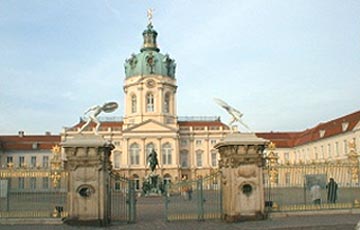












![]() Charlottenburg Palace is part of the Foundation Prussian palaces and gardens Berlin-Brandenburg and is thus their most important facility in Berlin. Today, it is the largest Hohenzollern residence in the German capital. The magnificent building is surrounded by a unique Barock garden.
Charlottenburg Palace is part of the Foundation Prussian palaces and gardens Berlin-Brandenburg and is thus their most important facility in Berlin. Today, it is the largest Hohenzollern residence in the German capital. The magnificent building is surrounded by a unique Barock garden.
![]() The dukedom Prussia was elevated to a kingdom in the year 1781 and elector Friedrich III of Brandenburg crowns himself King Frederick I of Prussia.
The dukedom Prussia was elevated to a kingdom in the year 1781 and elector Friedrich III of Brandenburg crowns himself King Frederick I of Prussia.
His wife Sophie Charlotte became queen. When the queen, only 36-year old died as a result of a cold, the palace Lietzenburg her favourite summer residence, it is being renamed as Palace Charlottenburg and the settlement becomes Charlottenburg.
The king gave the settlement the charter of a city.
Charlottenburg has as a suburb of Berlin in 1893, already 100000 citizens.
After the November revolution 1918 and the end of the Prussian Monarchy and Berlin merged with seven surrounding towns, 59 communities and 27 forest estate areas only then became Charlottenburg in 1920, one of 20 city districts.
![]() Transport Links:
Transport Links:
![]() U7 Richard-Wagner-Platz
U7 Richard-Wagner-Platz
![]() 145, 309 Schloss Charlottenburg, 109 Luisenplatz / Schloss Charlottenburg
145, 309 Schloss Charlottenburg, 109 Luisenplatz / Schloss Charlottenburg
![]() Address:
Address:
Schloss Charlottenburg
Spandauer Damm 20-24
14059 Berlin
![]() Tel. 030 / 32 09 14 11
Tel. 030 / 32 09 14 11
![]() Opening Times:
Opening Times:
For opening times and admission fees, please refer to the Website of the Foundation Preußische Schlösser und Gärten Berlin-Brandenburg
![]() Information about Prussian history and its royal family whose history is tightly connected with the state Prussia and also information about current projects and events is directly available at the official Website of the House Hohenzollern. A gallery of palaces informs about a selection of buildings and palaces and also about the Palace Charlottenburg.
Information about Prussian history and its royal family whose history is tightly connected with the state Prussia and also information about current projects and events is directly available at the official Website of the House Hohenzollern. A gallery of palaces informs about a selection of buildings and palaces and also about the Palace Charlottenburg.
![]() Detailed information about the palace architecture, the historic royal rooms and the palace park
Detailed information about the palace architecture, the historic royal rooms and the palace park
In 1695 under the direction of Johann Arnold Nering the building of a small pleasure palace for the elector's wife Sophie Charlotte started. When Nering died before the "Lietzenburg" (named after the village Lützenburg where it is situated)was completed Martin Grünberg was asked to finish the building, but had to hand the construction management to Johann Eosander Göthe a favourite of the elector's wife. Under the direction of Göthe two side wings were built, which were set aside for the servants. Johann Eosander Göthe added the protruding middle piece into the front building to create space for the nearly 50m high cupola tower. The cupola tower became the landmark of the palace. Between 1709 and 1712 an orangery was constructed at the palace's westside. Friedrich the great assigned Georg Wenzeslaus von Knobelsdorff for any further attachments to the palace. As a counterpiece to the orangery, a new wing with two ballrooms were added at the east side in 1740-1746. At the times of Friedrich Wilhelm II an orangery was built in 1788 under the direction of Carl Gotthard Langhans and also a small palace theatre so that the palace presents itself with a total length of 505m. The tea-house Belvedere at the Palace Park originated in the same years. Glamourous balls were given at the little palace at the time of the elector and the first Prussian Queen Sophie Charlotte. The Princess Liegnitz, wife of Friedrich Wilhelm III lived here in the 19th century. Friedrich Wilhelm IV has lived there also at times. The whole of the palace facility was heavily damaged during an air raid on 23rd November 1943. The palace has been reconstructed at great costs after the 2nd World War. The golden Fortuna on top of the cupola has been newly created by Richard Scheibe. Two replicas of the Borghesic fencer standing at the courtyard's entrance portal.
Palace and Palace Park are open to the public.
The palace houses apart from the historical rooms the museum for pre and early history as well as the gallery of romance. The Schinkel-Pavilion, the Belvedere and the mausoleum can be visited in the Palace Park. The mausoleum is only open from April to October.